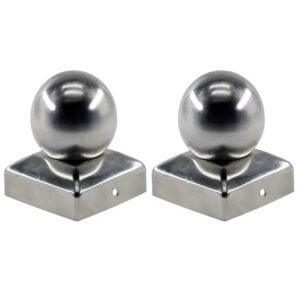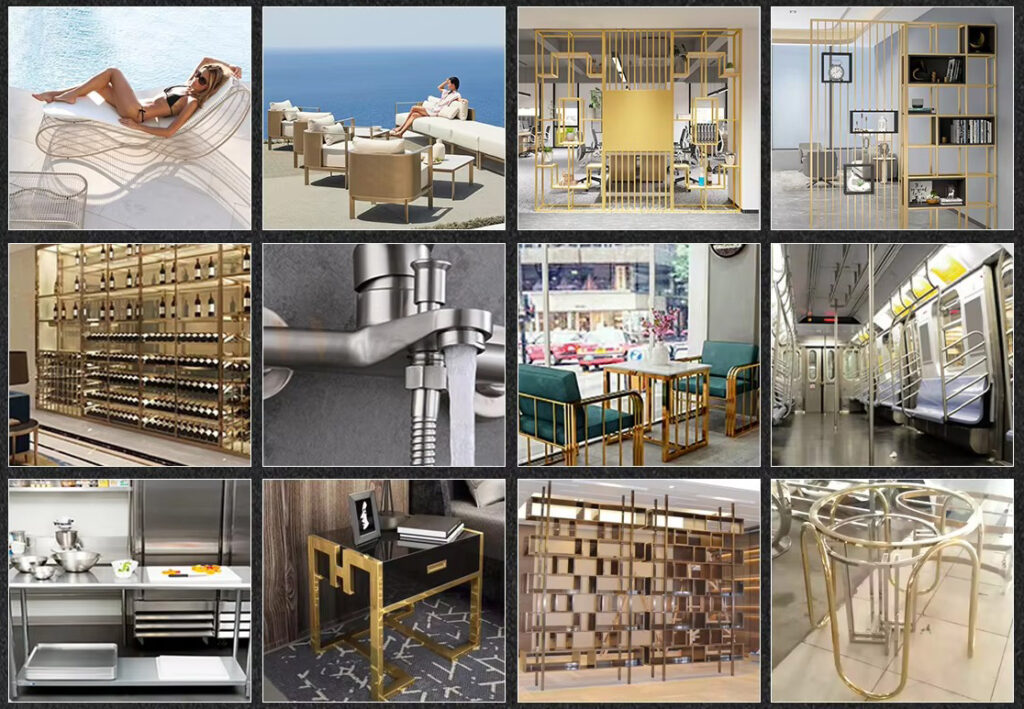
Post caps & end caps (round, square, decorative)
Post caps & end caps in 316L stainless steel. 23 years precision manufacturing for decorative applications worldwide. Request quote today.

Post caps & end caps in 316L stainless steel. 23 years precision manufacturing for decorative applications worldwide. Request quote today.

Square stainless steel posts in 304/316L grades. 23 years precision manufacturing for coastal projects worldwide. Request quote today.

Stainless steel posts in 304/316L grades. 23+ years ODM fabrication for marine & commercial applications. Contact factory today.

Square top rail components in 316L stainless steel. 23+ years precision manufacturing for global applications. Contact factory today.
Project-specific hardware in 316L stainless steel. 23 years delivering tailored solutions for specialized projects worldwide. Get factory quote today.
Non-standard size components in 316L stainless steel. 23+ years ODM manufacturing for unique sizing requirements globally. Contact us today.
| Specification | Our Commercial Systems | Standard Aluminum Systems | Competitive Advantage |
|---|---|---|---|
| Tensile Strength | 590 MPa (304/316 grade) | 300 MPa (6061-T6) | 97% stronger structural performance |
| Load Capacity | 200 lbs/linear foot | 125 lbs/linear foot | 60% higher load bearing capability |
| Corrosion Resistance | 500+ hours salt spray | 200 hours maximum | 150% superior marine environment performance |
| Operating Temperature | -40°C to +400°C | -30°C to +150°C | Extended thermal range for industrial processes |
| Wall Thickness | 3.0-6.0mm customizable | 2.0mm standard | Enhanced impact resistance and longevity |
| Maintenance Interval | 24-36 months | 6-12 months | 200% longer service cycles |
| Fire Resistance | Non-combustible Class A | Melts at 660°C | Superior fire safety performance |
| Chemical Compatibility | pH 1-14 resistant | pH 6-8 limited | Universal chemical process compatibility |
Structural Superiority vs. Alternative Materials
Commercial-grade stainless steel railing systems provide twice the fatigue performance of aluminum and maintain structural integrity under continuous high-load applications. Unlike powder-coated aluminum that requires repainting every 3-5 years, stainless steel’s inherent corrosion resistance eliminates coating failures that compromise safety in industrial environments.
Enhanced Load Distribution Engineering
Our heavy-duty systems utilize precision-welded construction that distributes concentrated loads across multiple connection points, preventing catastrophic failure modes common in bolted aluminum assemblies. The 590 MPa tensile strength enables 50% thinner profiles while maintaining superior load capacity compared to equivalent aluminum systems.
Chemical Process Environment Compatibility
While carbon steel railings require protective coatings that degrade under chemical exposure, stainless steel’s chromium oxide passivation layer self-repairs when scratched, maintaining corrosion protection in pH ranges from 1-14. This eliminates the coating maintenance cycles that create safety hazards and production downtime in chemical processing facilities.
High-Temperature Application Performance
Commercial kitchen and industrial process environments reaching 400°C exceed aluminum’s structural limits, causing warping and joint failures. Stainless steel maintains dimensional stability and load-bearing capacity at elevated temperatures where other materials become safety liabilities.
Chemical Processing Plant Walkway Systems
Petrochemical refineries and pharmaceutical manufacturing facilities require NACE-compliant railing systems that withstand hydrogen sulfide exposure, acid vapors, and thermal cycling between -20°C to +300°C without degradation or maintenance-induced shutdowns.
Food Processing Facility Platforms
Commercial meat processing and dairy production environments demand FDA-approved stainless steel systems with crevice-free construction, antimicrobial surface properties, and compatibility with high-pressure steam cleaning and caustic sanitizing chemicals.
Power Generation Infrastructure
Coal, natural gas, and nuclear power plants install seismic-rated stainless steel railings on turbine platforms, cooling tower access ways, and control room mezzanines where vibration resistance and 40-year service life requirements exceed aluminum capabilities.
Wastewater Treatment Plant Access Systems
Municipal and industrial treatment facilities require chlorine-resistant railing systems for clarifier walkways, chemical feed platforms, and aeration basin access where aluminum chloride corrosion creates safety hazards within 18 months.
Manufacturing Assembly Line Platforms
Automotive and aerospace production facilities utilize heavy-duty stainless steel railings on elevated work platforms, conveyor system walkways, and robotic cell enclosures where 24/7 operation and impact resistance are critical for worker safety.
Hospital and Laboratory Clean Room Systems
Pharmaceutical manufacturing and medical device clean rooms install electropolished stainless steel railings with seamless construction, validated cleaning protocols, and particle-free surfaces that maintain sterile environments essential for product quality.
What building codes and safety standards apply to commercial stainless steel railing systems?
Commercial installations must comply with IBC Section 1013.3 requiring 42-inch minimum height and IBC Section 1607.8 load requirements of 200 pounds concentrated and 50 pounds per linear foot uniform loads. Industrial facilities also follow OSHA 1910.23 standards for walking surfaces, with additional requirements for chemical exposure ratings and emergency egress specifications.
How do 304 and 316 stainless steel grades compare for different commercial environments?
304 stainless steel provides excellent performance for indoor commercial applications, food service, and general manufacturing environments. 316 grade with molybdenum addition offers superior chloride resistance for coastal facilities, chemical processing, and marine applications where salt exposure exceeds 5 miles from seawater. Industrial facilities with acid exposure require 316L low-carbon variants.
What are the total cost considerations for commercial stainless steel vs aluminum railing systems?
While initial material costs may be 30-40% higher, stainless steel systems deliver 70% lower total cost of ownership over 20-year lifecycles. Aluminum systems require repainting every 3-5 years at $15-25 per linear foot, plus structural replacement due to fatigue failure, while stainless steel requires only periodic cleaning with no refinishing costs.
How do load requirements differ between residential and commercial stainless steel railing applications?
Commercial systems must withstand 200 pounds concentrated loads and 50 pounds per linear foot uniform loads, compared to 200 pounds concentrated and 20 pounds per linear foot for residential applications. Industrial platforms may require additional dynamic loading analysis for vibrating equipment and seismic considerations not applicable to residential installations.
What maintenance protocols are required for commercial stainless steel railing systems?
Commercial environments require documented cleaning schedules using pH-neutral cleaners every 30-60 days depending on exposure levels. Chemical processing facilities need quarterly passivation treatments, while food processing requires daily sanitizing with approved compounds. Marine environments need salt removal cleaning every 15 days to maintain warranty compliance.
Can commercial stainless steel railings be customized for specific industrial processes?
Yes, our systems accommodate custom heights for ergonomic access, integrated cable management for control systems, specialized mounting for equipment clearance, and material certifications for pressure vessel codes. We provide engineering calculations for non-standard loading conditions and can incorporate heating elements for freeze protection in outdoor applications.
What fire safety advantages do stainless steel railings provide in commercial buildings?
Stainless steel maintains structural integrity at temperatures exceeding 800°C where aluminum softens and fails, providing critical egress path protection during fire events. The non-combustible classification eliminates flame spread concerns and toxic fume generation associated with polymer-coated aluminum systems in enclosed spaces.
How do commercial stainless steel systems perform in high-vibration industrial environments?
The superior fatigue resistance of stainless steel prevents crack propagation and joint loosening common in aluminum systems subjected to continuous machinery vibration. Welded construction eliminates mechanical fastener loosening, while the material’s damping properties reduce harmonic resonance that can cause catastrophic failure in lightweight aluminum assemblies.
Building Code Compliance Standards
Commercial stainless steel railing systems comply with IBC Section 1013 guard requirements and IBC Section 1012 handrail specifications for occupancy loads and accessibility provisions. Load testing follows ASTM E985 Standard Specification for permanent metal railing systems with documented proof load verification at 1.5 times design loads.
Industrial Safety Regulations
Manufacturing and process facility installations meet OSHA 1910.23 walking surface standards and NFPA 101 Life Safety Code egress requirements. Chemical processing applications comply with NACE SP0169 atmospheric corrosion guidelines and API 650 tank access standards for petroleum industry installations.
Material Specifications and Testing
All commercial-grade materials conform to ASTM A240 stainless steel specifications with certified mill test certificates documenting chemical composition and mechanical properties. Welding procedures follow AWS D1.1 structural standards with qualified welders and documented weld inspection protocols for critical load-bearing connections.
Quality Assurance Certifications
Manufacturing operates under ISO 9001:2015 quality management with documented material traceability and inspection procedures. Seismic applications require ICC-ES evaluation reports and structural engineering calculations sealed by professional engineers licensed in the installation jurisdiction.
Performance Testing Documentation
Salt spray testing per ASTM B117 standards demonstrates 500+ hour corrosion resistance exceeding marine environment requirements. Load testing follows ASTM E894 anchorage procedures with hydraulic test equipment documenting concentrated, uniform, and infill loading compliance for commercial applications.
Environmental and Safety Approvals
Food processing installations carry NSF International certification for direct food contact compatibility. Chemical processing applications meet ASME Boiler and Pressure Vessel Code material requirements with impact testing documentation for low-temperature service conditions.



